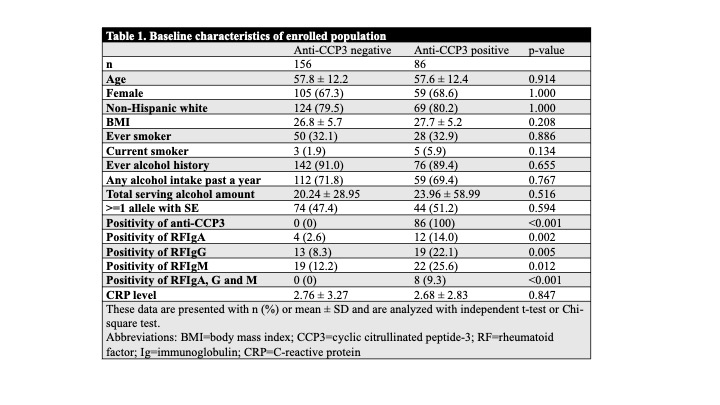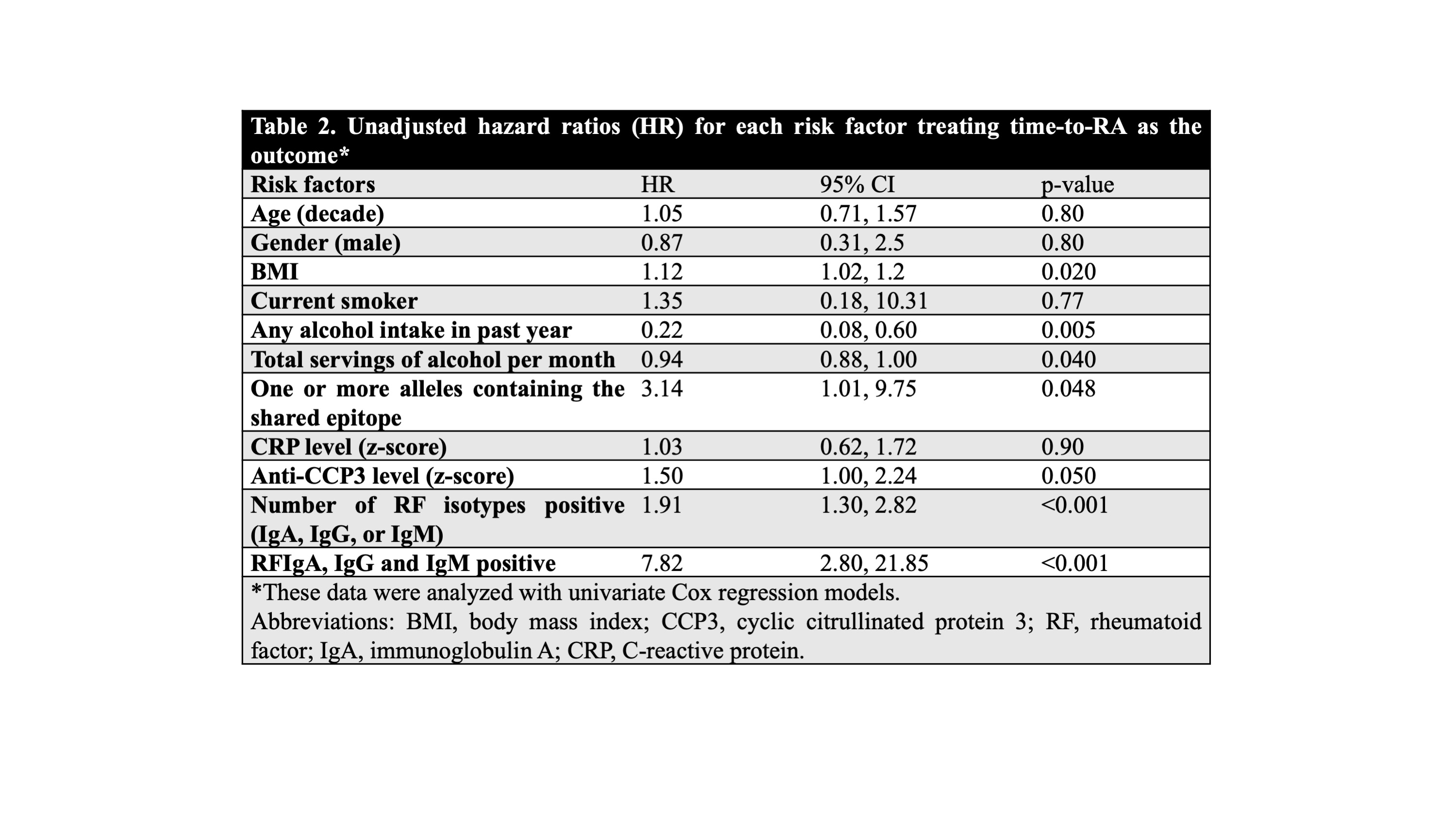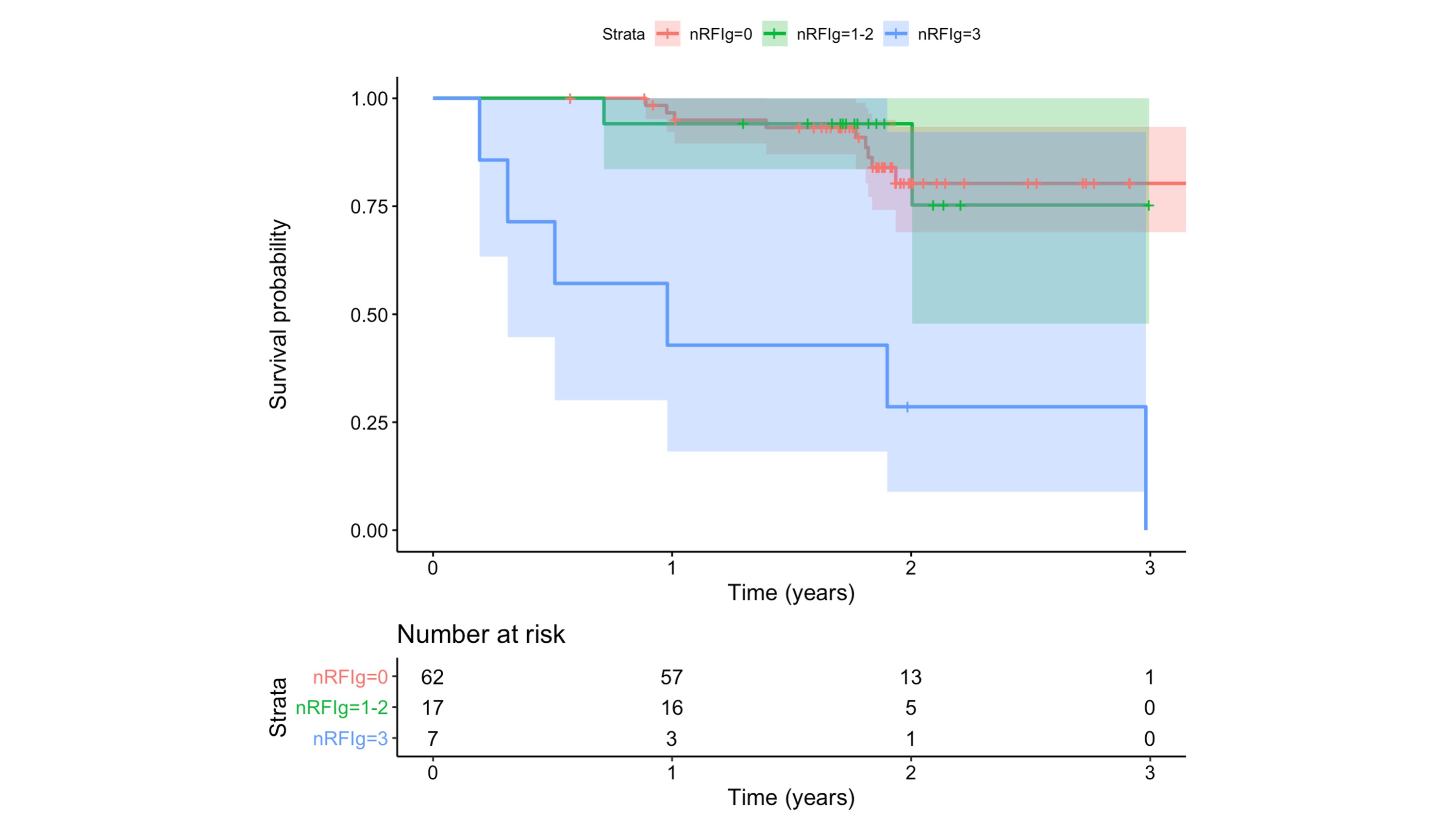Session Information
Date: Monday, November 9, 2020
Title: RA – Diagnosis, Manifestations, & Outcomes Poster IV: Lifespan of a Disease
Session Type: Poster Session D
Session Time: 9:00AM-11:00AM
Background/Purpose: Individuals at high-risk for future rheumatoid arthritis (RA) may be identified by screening for circulating RA-related autoantibodies including antibodies to citrullinated protein antigens (ACPA). The purpose of this study was to evaluate a new cohort of ACPA+ individuals to identify factors associated with progression to and timing of inflammatory arthritis (IA) onset in order to develop prediction models and to identify factors that may be target candidates for prevention.
Methods: ACPA- healthy controls (n=156) and ACPA+ subjects without IA at baseline (n=86) were enrolled in the Targeting Immune Responses for Prevention of Rheumatoid Arthritis (TIP-RA) study. Subjects were identified through clinics, and screening of relatives of patients with RA, and health-fairs. Clinical characteristics and laboratory results were obtained every year for up to 3 years’ follow-up. ACPA was evaluated by anti-CCP3 (IgG, Inova) and rheumatoid factor (RF) by ELISA for IgA, IgG and IgM isotypes (Inova). Other biomarkers included assessment of C-reactive protein and the shared epitope (SE). Baseline clinical and biomarker characteristics were compared between ACPA-positive individuals who developed RA and those who did not. In addition, univariate Cox regression analyses were used to estimate hazard ratios (HRs) for each risk factor of RA development.
Results: Characteristics of the ACPA- and ACPA+ subjects are presented in Table 1. Among the 86 ACPA+ subjects, 18 (20.9%) developed RA after a mean of 470 days from baseline, with 15/18 (83.3%) meeting ACR/EULAR classification criteria at the time of presentation of IA. Within the ACPA+ subjects, a higher BMI was associated with an increased risk for developing IA/RA (Table 2); in contrast, any alcohol intake in the past year was associated with decreased risk of IA/RA. Past or current smoking was not associated with increased risk for IA/RA, although rates of smoking were low. The presence of one or more alleles containing the SE was also associated with increased risk of incident IA/RA. Furthermore, within the ACPA+ subjects, for every additional RF isotype that was positive, the risk for incident IA/RA increased by 91%. In particular, baseline positivity of RFIgA, IgG and IgM was associated with the highest risk of development of IA/RA (Table 2 and Figure 1).
Conclusion: The findings of an increased risk of incident IA/RA in ACPA+ subjects associated with higher BMI and lower risk associated with alcohol intake replicate findings from other studies (de Hair 2012; Scott 2013). Moreover, these findings suggest that BMI and alcohol are mechanistically related to biologic pathways in propagation from autoimmunity to clinically-apparent IA/RA; these findings also support that modification of these factors may be considered in RA prevention (Zacchardeli 2019). In addition, the increased risk of incident IA/RA with SE and RF isotype positivity, respectively, suggests these markers can be used to improve prediction of the imminent onset of RA; these latter findings also highlight the importance of the SE and RFs in the pathophysiology of RA development and especially in the transition from Pre-RA to clinically-apparent disease.
 Table 1. Baseline characteristics of enrolled population
Table 1. Baseline characteristics of enrolled population
 Table 2. Unadjusted hazard ratios (HR) for each risk factor treating time-to-RA as the outcome
Table 2. Unadjusted hazard ratios (HR) for each risk factor treating time-to-RA as the outcome
 Figure 1. RA-free survival stratified by baseline RF Ig status. Note, nRFIg=0 (red line) if neither IgM, IgA, nor IgG were positive, RFIg=1-2 (green line) if any 1 or two of RF isotypes were positive, and RFIg = 3 (blue line) if all three RF isotypes were positive.
Figure 1. RA-free survival stratified by baseline RF Ig status. Note, nRFIg=0 (red line) if neither IgM, IgA, nor IgG were positive, RFIg=1-2 (green line) if any 1 or two of RF isotypes were positive, and RFIg = 3 (blue line) if all three RF isotypes were positive.
To cite this abstract in AMA style:
Kim H, Peterson R, Firestein G, Boyle D, Buckner J, Posso S, James E, Robinson W, Arbet J, Moss L, Gilmore R, Hartje L, Barzideh S, Seifert J, Rao N, Baribaud F, Nagpal S, Johnson A, Holers V, D. Deane K. Factors Associated with an Increased Risk of Imminent Rheumatoid Arthritis in ACPA+ Individuals [abstract]. Arthritis Rheumatol. 2020; 72 (suppl 10). https://acrabstracts.org/abstract/factors-associated-with-an-increased-risk-of-imminent-rheumatoid-arthritis-in-acpa-individuals/. Accessed .« Back to ACR Convergence 2020
ACR Meeting Abstracts - https://acrabstracts.org/abstract/factors-associated-with-an-increased-risk-of-imminent-rheumatoid-arthritis-in-acpa-individuals/
